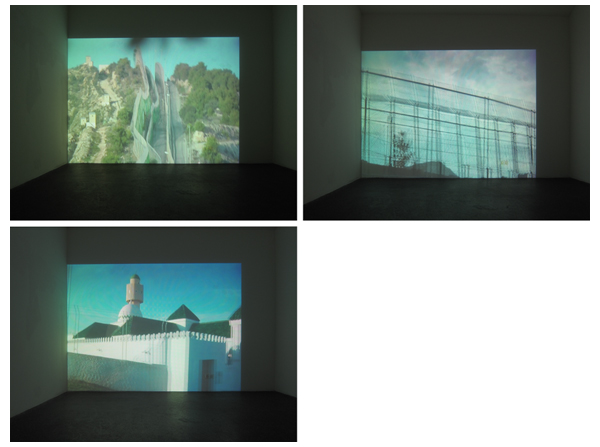In this context, they see the theme of »translation« not only in the linguistic sense but above all as a spatial and formal-aesthetic principle by which to create multilayered situational transfers. The aspect of transposition and interpretation that is decisive in any translation process, becomes evident in the video »La valla es europeo. The Fence is European.«. During a taxi drive along the fence between Morocco and Melilla, the complexity and explosiveness of the political situation in North Africa is explained in simple words by the taxi driver engaged by Tinzl and Flunger. So that the non-Spanish-speaking passengers can also understand what he has to say, the chauffeur comments on the high barrier – which is erected in three rows and topped with NATO-wire – in an insistent manner throughout the entire trip. However, the viewers of the video do not hear the language of the man from Melilla but a German transcription, which is spoken onto the soundtrack by a local taxi driver. In »La valla es europeo. The Fence is European.« Johanna Tinzl and Stefan Flunger break away from the use of purely documentary strategies in the sphere of art by consciously avoiding documenting up-to-date stories of individual immigrants and so reifying them for the purposes of their art. The language of the taxi driver from the Spanish exclave is used in order to create a connection between the realities of life on the external borders of Europe and those in Central Europe. When the artists show this video in different places, the text from the man from Melilla is translated into the language of the relevant country and repeated by a local taxi driver.

collaboration since 2004
Johanna Tinzl
2007 – 2002 University of Applied Arts Vienna – Transmedia Art
2002 – 1996 University Mozarteum Salzburg
Stefan Flunger
1999 – 1989 University of Innsbruck – Institute of Art History
Solo exhibitions
Neue Galerie, Innsbruck (2011) // VBKÖ, Vienna (2011)
Group exhibitions (selection)
Reinsberg – Public Art – Lower Austria (2011) // Hotel Charleroi – in Coop. with B.P.S.22, Charleroi, Belgium (2011) //
unORTnung VI-III (2010-2008), Vienna // Kunstraum Niederösterreich, Vienna (2010) // Kunstpavillon, Innsbruck (2010) //
BKS Garage, Copenhagen (2010) // Gallery Konzett, Vienna (2009) // Essl Museum, Klosterneuburg (2008) // …